| Listing 1 - 10 of 151 | << page >> |
Sort by
|
Film
Year: 2021 Publisher: Bruxelles FEC
Abstract | Keywords | Export | Availability | Bookmark
 Loading...
Loading...Choose an application
- Reference Manager
- EndNote
- RefWorks (Direct export to RefWorks)
Sans précédent dans l'histoire du travail, des millions d'êtres humains se sont vus contraints par l'entremise d'une pandémie de rester chez eux et de télétravailler.Dans nos sociétés capitalistes dominées par le secteur tertiaire où l'espace de bureau, sous toutes ses formes, est au cœur même du système, cet événement va sans nul doute profondément modifier le rapport au travail. D'ici peu le travail à domicile ou télétravail sera une des principales modalités de l'organisation générale du travail.Le travailleur en sortira-t-il gagnant ? Pas si sûr même si une majorité de travailleurs dit vouloir télétravailler davantage. Disparition du collectif, isolement, augmentation du temps de travail, invasion de la sphère privée, droit à la déconnexion, coûts à charge du travailleur, ... sont autant de questions auxquelles cette flexibilité nouvelle nous demande de répondre."À distance" vous propose de partir à la rencontre d'expériences concrètes et d'entamer, en compagnie de philosophes, sociologues, syndicalistes, responsables de structures, un voyage réflexif dans notre futur de travailleur. Le film est accompagné de 4 PRÉCIPITÉS.
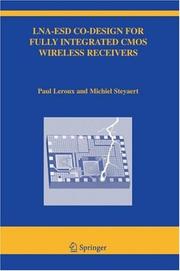
ISBN: 1280283521 9786610283521 1402031912 1402031904 1441952675 9781402031915 9780387522777 Year: 2005 Publisher: Dordrecht ; New York : Springer,
Abstract | Keywords | Export | Availability | Bookmark
 Loading...
Loading...Choose an application
- Reference Manager
- EndNote
- RefWorks (Direct export to RefWorks)
LNA-ESD Co-Design for Fully Integrated CMOS Wireless Receivers fits in the quest for complete CMOS integration of wireless receiver front-ends. With a combined discussion of both RF and ESD performance, it tackles one of the final obstacles on the road to CMOS integration. The book is conceived as a design guide for those actively involved in the design of CMOS wireless receivers. The book starts with a comprehensive introduction to the performance requirements of low-noise amplifiers in wireless receivers. Several popular topologies are explained and compared with respect to future technology and frequency scaling. The ESD requirements are introduced and related to the state-of-the-art protection devices and circuits. LNA-ESD Co-Design for Fully Integrated CMOS Wireless Receivers provides an extensive theoretical treatment of the performance of CMOS low-noise amplifiers in the presence of ESD-protection circuitry. The influence of the ESD-protection parasitics on noise figure, gain, linearity, and matching are investigated. Several RF-ESD co-design solutions are discussed allowing both high RF-performance and good ESD-immunity for frequencies up to and beyond 5 GHz. Special attention is also paid to the layout of both active and passive components. LNA-ESD Co-Design for Fully Integrated CMOS Wireless Receivers offers the reader intuitive insight in the LNA’s behavior, as well as the necessary mathematical background to optimize its performance. All material is experimentally verified with several CMOS implementations, among which a fully integrated GPS receiver front-end. The book is essential reading for RF design engineers and researchers in the field and is also suitable as a text book for an advanced course on the subject.
Amplifiers (Electronics) --- Metal oxide semiconductors, Complementary. --- Digital communications. --- Communications, Digital --- Digital transmission --- Pulse communication --- Digital electronics --- Pulse techniques (Electronics) --- Telecommunication --- Digital media --- Signal processing --- CMOS (Electronics) --- Complementary metal oxide semiconductors --- Semiconductors, Complementary metal oxide --- Logic circuits --- Transistor-transistor logic circuits --- Amps (Electronics) --- Electronic amplifiers --- Radio amplifiers --- Electronics --- Design and construction. --- Digital techniques --- Digital communications --- Metal oxide semiconductors, Complementary --- Design and construction --- Computer engineering. --- Engineering design. --- Electronics. --- Electrical Engineering. --- Engineering Design. --- Electronics and Microelectronics, Instrumentation. --- Electrical engineering --- Physical sciences --- Design, Engineering --- Engineering --- Industrial design --- Strains and stresses --- Computers --- Design --- 621.382 --- CMOS --- Computer engineering --- GPS --- Halfgeleiders --- Telecommunicatie --- Digitale communicatie --- Electrical engineering. --- Microelectronics. --- Microminiature electronic equipment --- Microminiaturization (Electronics) --- Microtechnology --- Semiconductors --- Miniature electronic equipment --- Electric engineering
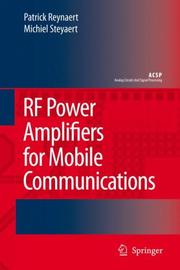
ISBN: 1280701064 9786610701063 1402051174 1402051166 9781402051166 9781402051173 9048172861 Year: 2006 Publisher: Dordrecht : Springer,
Abstract | Keywords | Export | Availability | Bookmark
 Loading...
Loading...Choose an application
- Reference Manager
- EndNote
- RefWorks (Direct export to RefWorks)
RF Power Amplifiers for Mobile Communications fits in the quest for fully integrated CMOS transceivers. The book tackles both high efficiency and high linearity PA design in low-voltage CMOS, and has a strong emphasis on theory, design and implementation. The book is conceived as a design guide for those actively involved in the design of CMOS wireless transceivers. RF Power Amplifiers for Mobile Communications starts from the basic theory of power amplification from the viewpoint of CMOS integration. The design of switching RF power amplifiers in CMOS is explored and CMOS PA design at low supply voltage using parallel amplification is discussed. Combining both efficiency and linearity is one of the major issues in CMOS PA design for wireless and mobile communications and is subsequently tackled. Different linearization techniques and approaches are discussed and polar modulation is clarified in greater detail. Finally, two CMOS PA implementations are thoroughly covered. RF Power Amplifiers for Mobile Communications offers the reader an intuitive insight in Power Amplification as well as the necessary mathematical background. The book is essential reading for RF design engineers and researchers in the field and is also suitable as a text book for an advanced course on the subject.
Power amplifiers. --- Mobile communication systems. --- Amplifiers, Radio frequency. --- Radio frequency amplifiers --- Amplifiers (Electronics) --- Vehicles --- Vehicular communication systems --- Radio --- Wireless communication systems --- Communication systems --- Computer engineering. --- Microwaves. --- Electronics. --- Systems engineering. --- Telecommunication. --- Electrical Engineering. --- Microwaves, RF and Optical Engineering. --- Electronics and Microelectronics, Instrumentation. --- Circuits and Systems. --- Signal, Image and Speech Processing. --- Communications Engineering, Networks. --- Electric communication --- Mass communication --- Telecom --- Telecommunication industry --- Telecommunications --- Communication --- Information theory --- Telecommuting --- Engineering systems --- System engineering --- Engineering --- Industrial engineering --- System analysis --- Electrical engineering --- Physical sciences --- Hertzian waves --- Electric waves --- Electromagnetic waves --- Geomagnetic micropulsations --- Radio waves --- Shortwave radio --- Computers --- Design and construction --- Electrical engineering. --- Optical engineering. --- Microelectronics. --- Electronic circuits. --- Signal processing. --- Image processing. --- Speech processing systems. --- Computational linguistics --- Electronic systems --- Modulation theory --- Oral communication --- Speech --- Telecommunication --- Singing voice synthesizers --- Pictorial data processing --- Picture processing --- Processing, Image --- Imaging systems --- Optical data processing --- Processing, Signal --- Information measurement --- Signal theory (Telecommunication) --- Electron-tube circuits --- Electric circuits --- Electron tubes --- Electronics --- Microminiature electronic equipment --- Microminiaturization (Electronics) --- Microtechnology --- Semiconductors --- Miniature electronic equipment --- Mechanical engineering --- Electric engineering
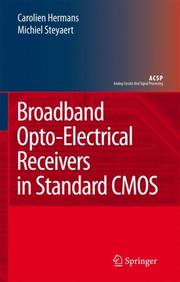
ISBN: 1280937491 9786610937493 1402062222 1402062214 9048175720 Year: 2007 Publisher: Dordrecht : Springer Verlag,
Abstract | Keywords | Export | Availability | Bookmark
 Loading...
Loading...Choose an application
- Reference Manager
- EndNote
- RefWorks (Direct export to RefWorks)
Broadband Opto-Electrical Receivers in Standard CMOS fits in the quest for integrated opto-electrical solutions, and focuses on the receiver front-end. To further reduce the cost, the cheapest technology is selected: standard CMOS, without any optical tricks or flavors. The emphasis is on the analysis, design and implementation of high-performance analog receiver circuits. Broadband Opto-Electrical Receivers in Standard CMOS starts from the basic fundamentals, necessary for the design of opto-electronic interface circuits. The book continues with an in-depth analysis of the photodiode, transimpedance amplifier (TIA) and limiting amplifier (LA). To thoroughly understand the light detection mechanisms in silicon, first a one-dimensional and second a two-dimensional model is developed. Analytical design equations are derived to guide the design of the amplifying circuits. For the TIA, the focus lies on the sensitivity-speed trade-off. For the LA, a high gain-bandwidth is pursued. Several practical design examples reveal the subtleties and challenges encountered during the design of high-performance analog circuits. Broadband Opto-Electrical Receivers in Standard CMOS covers the total design flow of monolithic CMOS optical receivers. All material is experimentally verified with several CMOS implementations, with ultimately a fully integrated Gbit/s optical receiver front-end including photodiode, TIA and LA. The book is essential reading for analog design engineers and researchers in the field and is also suitable as a text book for an advanced course on the subject.
Photodiodes. --- Optical amplifiers. --- Metal oxide semiconductors, Complementary. --- Amplifiers, Optical --- Light amplifiers --- Optoelectronic devices --- Photoconductor diodes --- Diodes, Semiconductor --- Optical detectors --- CMOS (Electronics) --- Complementary metal oxide semiconductors --- Semiconductors, Complementary metal oxide --- Digital electronics --- Logic circuits --- Transistor-transistor logic circuits --- Systems engineering. --- Electronics. --- Circuits and Systems. --- Electronics and Microelectronics, Instrumentation. --- Optics, Lasers, Photonics, Optical Devices. --- Electrical engineering --- Physical sciences --- Engineering systems --- System engineering --- Engineering --- Industrial engineering --- System analysis --- Design and construction --- Electronic circuits. --- Microelectronics. --- Lasers. --- Photonics. --- New optics --- Optics --- Light amplification by stimulated emission of radiation --- Masers, Optical --- Optical masers --- Light sources --- Nonlinear optics --- Optical parametric oscillators --- Microminiature electronic equipment --- Microminiaturization (Electronics) --- Electronics --- Microtechnology --- Semiconductors --- Miniature electronic equipment --- Electron-tube circuits --- Electric circuits --- Electron tubes
Book
ISBN: 128118019X 9786611180195 1402067909 1402067895 9048177286 9781402067891 9781402067907 Year: 2008 Publisher: Dordrecht : Springer,
Abstract | Keywords | Export | Availability | Bookmark
 Loading...
Loading...Choose an application
- Reference Manager
- EndNote
- RefWorks (Direct export to RefWorks)
Design of high voltage xDSL line drivers in standard CMOS fits in the quest for highly efficient fully integrated xDSL modems for central office applications. The book focusses on the line driver, the most demanding building block of the xDSL modem for lowering power. To reduce the cost, the cheapest technology is selected: standard CMOS, without any extra process options to increase the nominal supply voltage. The emphasis lies on the analysis, design and implementation of high voltage highly efficient line drivers in mainstream CMOS. Design of high voltage xDSL line drivers in standard CMOS starts from the Self-Oscillating Power Amplifier (SOPA), a highly efficient line driver for xDSL applications. However, in the nano-electronic era, the low supply voltage of CMOS results in very low efficiencies for line drivers and power amplifiers in general. In this book a technique is developed for designing high voltage circuits in a low voltage mainstream CMOS technology. Several practical design examples reveal the subtleties and challenges encountered during the design of high voltage circuits in low voltage standard CMOS. Such a high voltage buffer is then integrated into the SOPA architecture leading to the implementation of a high voltage highly efficient aDSL2+ line driver in a 1.2V 130nm mainstream CMOS technology. Design of high voltage xDSL line drivers in standard CMOS covers the total design flow of monolithic CMOS high voltage circuits. The book is essential reading for analog design engineers and researchers in the field and is also suitable as a text book for an advanced course on the subject.
Line drivers (Integrated circuits) --- Metal oxide semiconductors, Complementary. --- Design and construction. --- CMOS (Electronics) --- Complementary metal oxide semiconductors --- Semiconductors, Complementary metal oxide --- Digital electronics --- Logic circuits --- Transistor-transistor logic circuits --- Buffers, Tri-state (Integrated circuits) --- Drivers, Line (Integrated circuits) --- Tri-state buffers (Integrated circuits) --- Amplifiers (Electronics) --- Computer interfaces --- Integrated circuits --- Systems engineering. --- Electronics. --- Computer engineering. --- Telecommunication. --- Circuits and Systems. --- Electronics and Microelectronics, Instrumentation. --- Electrical Engineering. --- Communications Engineering, Networks. --- Electric communication --- Mass communication --- Telecom --- Telecommunication industry --- Telecommunications --- Communication --- Information theory --- Telecommuting --- Computers --- Electrical engineering --- Physical sciences --- Engineering systems --- System engineering --- Engineering --- Industrial engineering --- System analysis --- Design and construction --- Electronic circuits. --- Microelectronics. --- Electrical engineering. --- Electric engineering --- Microminiature electronic equipment --- Microminiaturization (Electronics) --- Electronics --- Microtechnology --- Semiconductors --- Miniature electronic equipment --- Electron-tube circuits --- Electric circuits --- Electron tubes --- Metal oxide semiconductors, Complementary
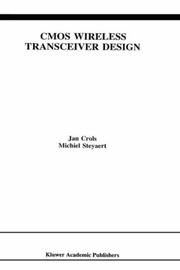
ISBN: 0792399609 1441951830 1475747845 9780792399605 Year: 1997 Volume: SECS 411 Publisher: Boston ; Dordrecht ; London Kluwer Academie Publishers
Abstract | Keywords | Export | Availability | Bookmark
 Loading...
Loading...Choose an application
- Reference Manager
- EndNote
- RefWorks (Direct export to RefWorks)
The world of wireless communications is changing very rapidly since a few years. The introduction of digital data communication in combination with digital signal process ing has created the foundation for the development of many new wireless applications. High-quality digital wireless networks for voice communication with global and local coverage, like the GSM and DECT system, are only faint and early examples of the wide variety of wireless applications that will become available in the remainder of this decade. The new evolutions in wireless communications set new requirements for the trans ceivers (transmitter-receivers). Higher operating frequencies, a lower power consump tion and a very high degree of integration, are new specifications which ask for design approaches quite different from the classical RF design techniques. The integrata bility and power consumption reduction of the digital part will further improve with the continued downscaling of technologies. This is however completely different for the analog transceiver front-end, the part which performs the interfacing between the antenna and the digital signal processing. The analog front-end's integratability and power consumption are closely related to the physical limitations of the transceiver topology and not so much to the scaling of the used technology. Chapter 2 gives a detailed study of the level of integration in current transceiver realization and analyzes their limitations. In chapter 3 of this book the complex signal technique for the analysis and synthesis of multi-path receiver and transmitter topologies is introduced.
Complementaire MOS transistoren --- Complementary metal oxide semiconductors --- MOS Transistoren [Complementaire ] --- Metal oxide semiconductors [Complementary ] --- Semiconductors [Complementary metal oxide ] --- Transistors MOS complémentaires --- Radio --- Metal oxide semiconductors, Complementary --- Signal processing --- Transmitter-receivers --- Design and construction --- Digital techniques --- Radio--Transmitter-receivers --- Electrical engineering. --- Computer-aided engineering. --- Electrical Engineering. --- Computer-Aided Engineering (CAD, CAE) and Design. --- CAE --- Engineering --- Electric engineering --- Data processing --- Radio - Transmitter-receivers - Design and construction --- Signal processing - Digital techniques
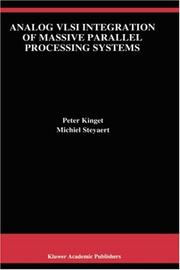
ISBN: 0792398238 9780792398233 1441951687 1475725809 Year: 1997 Publisher: Boston (Mass.) : Kluwer academic,
Abstract | Keywords | Export | Availability | Bookmark
 Loading...
Loading...Choose an application
- Reference Manager
- EndNote
- RefWorks (Direct export to RefWorks)
When comparing conventional computing architectures to the architectures of biological neural systems, we find several striking differences. Conventional computers use a low number of high performance computing elements that are programmed with algorithms to perform tasks in a time sequenced way; they are very successful in administrative applications, in scientific simulations, and in certain signal processing applications. However, the biological systems still significantly outperform conventional computers in perception tasks, sensory data processing and motory control. Biological systems use a completely dif ferent computing paradigm: a massive network of simple processors that are (adaptively) interconnected and operate in parallel. Exactly this massively parallel processing seems the key aspect to their success. On the other hand the development of VLSI technologies provide us with technological means to implement very complicated systems on a silicon die. Especially analog VLSI circuits in standard digital technologies open the way for the implement at ion of massively parallel analog signal processing systems for sensory signal processing applications and for perception tasks. In chapter 1 the motivations behind the emergence of the analog VLSI of massively parallel systems is discussed in detail together with the capabilities and !imitations of VLSI technologies and the required research and developments. Analog parallel signal processing drives for the development of very com pact, high speed and low power circuits. An important technologicallimitation in the reduction of the size of circuits and the improvement of the speed and power consumption performance is the device inaccuracies or device mismatch.
Linear integrated circuits. --- Parallel processing (Electronic computers) --- Signal processing --- Neural networks (Computer science) --- Circuits intégrés linéaires --- Parallélisme (Informatique) --- Traitement du signal --- Réseaux neuronaux (Informatique) --- Digital techniques. --- Techniques numériques --- Linear integrated circuits --- Digital techniques --- Neural networks (Computer science). --- Parallel processing (Electronic computers). --- Electrical engineering. --- Statistical physics. --- Dynamical systems. --- Signal processing. --- Image processing. --- Speech processing systems. --- Electrical Engineering. --- Complex Systems. --- Signal, Image and Speech Processing. --- Statistical Physics and Dynamical Systems. --- Computational linguistics --- Electronic systems --- Information theory --- Modulation theory --- Oral communication --- Speech --- Telecommunication --- Singing voice synthesizers --- Pictorial data processing --- Picture processing --- Processing, Image --- Imaging systems --- Optical data processing --- Processing, Signal --- Information measurement --- Signal theory (Telecommunication) --- Dynamical systems --- Kinetics --- Mathematics --- Mechanics, Analytic --- Force and energy --- Mechanics --- Physics --- Statics --- Mathematical statistics --- Electric engineering --- Engineering --- Statistical methods --- Digital signal processing --- Digital communications --- Digital electronics --- Linear ICs --- Analog integrated circuits --- High performance computing --- Multiprocessors --- Parallel programming (Computer science) --- Supercomputers --- Signal processing - Digital techniques
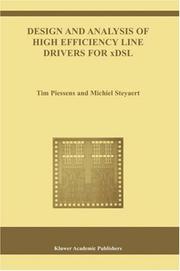
ISBN: 1402025181 1402077270 Year: 2004 Publisher: Boston : Kluwer Academic Publishers,
Abstract | Keywords | Export | Availability | Bookmark
 Loading...
Loading...Choose an application
- Reference Manager
- EndNote
- RefWorks (Direct export to RefWorks)
Design and Analysis of High Efficiency Line Drivers for xDSL covers the most important building block of an xDSL (ADSL, VDSL, ) system: the line driver. Traditional Class AB line drivers consume more than 70 per cent of the total power budget of state-of-the-art ADSL modems. This book describes the main difficulties in designing line drivers for xDSL. The most important specifications are elaborated staring from the main properties of the channel and the signal properties. The traditional (class AB), state-of-the-art (class G) and future technologies (class K) are discussed. The main part of Design and Analysis of High Efficiency Line Drivers for xDSL describes the design of a novel architecture: the Self-Oscillating Power Amplifier or SOPA. This architecture uses a non-linear, asynchronous modulation scheme that enables highly efficient, highly linear transmission. The concept has been proven by two implementations in a digital CMOS technology: a G-Lite compliant line driver with 61 per cent efficiency and a full ADSL-VDSL downstream compliant power amplifier with 47 per cent power efficiency. The proposed architecture is fully analysed and complete design plans including CMOS sca.
Digital subscriber lines --- Line drivers (Integrated circuits) --- Buffers, Tri-state (Integrated circuits) --- Drivers, Line (Integrated circuits) --- Tri-state buffers (Integrated circuits) --- Amplifiers (Electronics) --- Computer interfaces --- Integrated circuits --- DSLs (Digital subscriber lines) --- Digital communications --- Telephone lines --- Design and construction --- Integrated Circuits --- Technology & Engineering --- Digital subscriber lines. --- Design and construction.
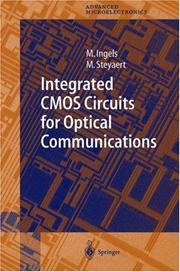
ISSN: 14370387 ISBN: 3540202099 9783540202097 3642057764 3662079267 Year: 2004 Volume: 14 Publisher: Berlin Springer
Abstract | Keywords | Export | Availability | Bookmark
 Loading...
Loading...Choose an application
- Reference Manager
- EndNote
- RefWorks (Direct export to RefWorks)
This book presents several circuits that are required for the full integration of an optical transmitter in standard CMOS. The main emphasis is placed on high-speed receivers with a bitrate of up to 1 Gb/s. The possibility of including the photodiode in a receiver is investigated and the problems encountered are discussed. Concerning the transmitter aspect, a CMOS LED driver is described. The final chapter addresses electrical interference problems on a chip and proposes countermeasures. The various circuits in this book have all been realized and measurement results are presented, paving the way for single chip communication systems in which the optical interfaces are integrated on the same die as the digital circuitry.
Optical detectors --- Metal oxide semiconductors, Complementary --- Integrated circuits --- CMOS --- Analog --- Optical receiver --- Opto-electronics --- Transimpedance --- Integrated circuit --- 621.382 --- Light-sensitive cells --- Light-sensitive detectors --- Light sensor photodevices --- Photodetectors --- Photodevices, Light sensor --- Photoelectric detectors --- Photosensors --- Detectors --- Optical transducers --- Optoelectronic devices --- CMOS (Electronics) --- Complementary metal oxide semiconductors --- Semiconductors, Complementary metal oxide --- Digital electronics --- Logic circuits --- Transistor-transistor logic circuits --- Chips (Electronics) --- Circuits, Integrated --- Computer chips --- Microchips --- Electronic circuits --- Microelectronics --- Electrical engineering. --- Lasers. --- Photonics. --- Optical materials. --- Electronic materials. --- Microwaves. --- Optical engineering. --- Electronics. --- Microelectronics. --- Communications Engineering, Networks. --- Optics, Lasers, Photonics, Optical Devices. --- Optical and Electronic Materials. --- Microwaves, RF and Optical Engineering. --- Electronics and Microelectronics, Instrumentation. --- Microminiature electronic equipment --- Microminiaturization (Electronics) --- Electronics --- Microtechnology --- Semiconductors --- Miniature electronic equipment --- Electrical engineering --- Physical sciences --- Mechanical engineering --- Hertzian waves --- Electric waves --- Electromagnetic waves --- Geomagnetic micropulsations --- Radio waves --- Shortwave radio --- Electronic materials --- Optics --- Materials --- New optics --- Light amplification by stimulated emission of radiation --- Masers, Optical --- Optical masers --- Light amplifiers --- Light sources --- Nonlinear optics --- Optical parametric oscillators --- Electric engineering --- Engineering
Book
ISBN: 9400714351 940071436X 9789400714359 9789400714366 Year: 2011 Publisher: Dordrecht, The Netherlands : Springer,
Abstract | Keywords | Export | Availability | Bookmark
 Loading...
Loading...Choose an application
- Reference Manager
- EndNote
- RefWorks (Direct export to RefWorks)
Technological progress in the semiconductor industry has led to a revolution towards new advanced, miniaturized, intelligent, battery-operated and wireless electronic applications. The required supply voltage(s) of these applications seldom matches the varying battery voltage, due to technological reasons. Therefore, efficient voltage converters are crucial to bridge this voltage gap, without compromising the battery’s autonomy as do linear voltage converters. In addition, both space and cost constraints form a strong incentive towards fully-integrated CMOS switched-mode DC-DC converters, effectively eliminating the need for large and expensive off-chip passives (inductors and capacitors). To achieve this goal Fully-Integrated Inductive DC-DC Converters in Standard CMOS provides the following assets: A firm but comprehensive theoretical base on switched-mode DC-DC converters, giving the designer the crucial information for understanding the operating principles and fundamental limitations of different types of DC-DC converters, including linear converters, charge-pump converters and inductive converters. An overview and comparison of different types of inductive DC-DC converters and their mutual comparison towards monolithic integration provides a versatile knowledge base to match witch the constraints of the converter to be designed. An accurate and fast model for fully-integrated inductive DC-DC converters is discussed, taking into account all the significant losses in CMOS technologies. This model allows very accurate prediction of the steady-state parameters, including the efficiency. Furthermore, it allows a fast convergence towards the optimal design values, despite the multi-dimensional design-space. High-speed control schemes for controlling the output voltage are explained intuitively and from a practical point of view. In addition three new control concepts: COOT, SCOOT and F²SCOOT are revealed. Many concrete schematics are provided and explained, which are also used in the various chip realizations. As such, this hands-on approach provides the “feeling” for control system design for fully-integrated DC-DC converters to the designer. The book is concluded with seven practical proof-of-concept chip realizations of fully-integrated DC-DC converters, thereby using both bondwire and metal-track inductors. Many practical issues, such as chip lay-out and measurement setups, are discussed, providing the designer even more to-the-point practical information on the subject. Fully-Integrated Inductive DC-DC Converters in Standard CMOS is an essential work for research and design engineers that are confronted with fully- and/or highly-integrated DC-DC converters. The approach in this book ranges from a firm theoretical base to understand the trade-offs, towards a highly practical and realistic mindset.
Electric machinery -- Automatic control. --- Electric machinery -- Direct current. --- Electric machinery -- Mathematical models. --- Electric machinery. --- DC-to-DC converters --- Electric current converters --- Metal oxide semiconductors, Complementary --- Electrical & Computer Engineering --- Engineering & Applied Sciences --- Electrical Engineering --- Metal oxide semiconductors, Complementary. --- Design. --- Direct current to direct current converters --- CMOS (Electronics) --- Complementary metal oxide semiconductors --- Semiconductors, Complementary metal oxide --- Engineering. --- Input-output equipment (Computers). --- Solid state physics. --- Electronic circuits. --- Circuits and Systems. --- Input/Output and Data Communications. --- Solid State Physics. --- Electron-tube circuits --- Electric circuits --- Electron tubes --- Electronics --- Physics --- Solids --- Computer hardware --- Computer I/O equipment --- Computers --- Electronic analog computers --- Electronic digital computers --- Hardware, Computer --- I/O equipment (Computers) --- Input equipment (Computers) --- Input-output equipment (Computers) --- Output equipment (Computers) --- Computer systems --- Construction --- Industrial arts --- Technology --- Input-output equipment --- Digital electronics --- Logic circuits --- Transistor-transistor logic circuits --- Systems engineering. --- Data transmission systems. --- Data communication systems --- Transmission of data --- Digital communications --- Electronic data processing --- Electronic systems --- Information theory --- Telecommunication systems --- Engineering systems --- System engineering --- Engineering --- Industrial engineering --- System analysis --- Design and construction
| Listing 1 - 10 of 151 | << page >> |
Sort by
|

 Search
Search Feedback
Feedback About UniCat
About UniCat  Help
Help News
News